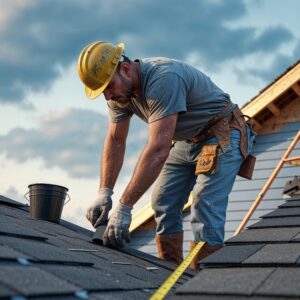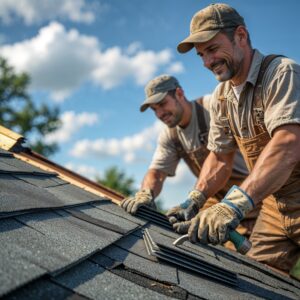Roofing is a technical process that demands a variety of specialised tools and equipment to ensure a durable and secure finish. These include everything from basic hammers and utility knives to efficiently working nail guns. Roofing tools are vital for quality construction and to save the workers throughout the project. Proper roofing harnesses, wearing hard hats, and slip-resistant sole shoes offer safety without fear of falls and injury.
List of Tools For Roofing
| Tool | Use |
| Roofing Ladder | Ensures safe and stable access to the roof. |
| Utility Knife | Cuts roofing materials like shingles, underlayment, and flashing. |
| Measuring Tape | Measures roof dimensions accurately for material calculation. |
| Chalk Line | Creates straight, visible lines for precise alignment of shingles. |
| Roofing Harness | Provides fall protection and ensures worker safety. |
| Hard Hats and Safety Glasses | Protects the head and eyes from falling debris and other hazards. |
| Nail Gun | Quickly drives nails into shingles or other roofing materials. |
| Circular Saw | Cuts plywood, decking, or other thick materials for roofing projects. |
| Reciprocating Saw | Used for cutting through nails, fasteners, or other tough materials. |
| Pry Bar | Removes old shingles, nails, and flashing from the roof. |
| Shovel | Helps in removing old roofing materials, especially heavy debris. |
| Tin Snips | Cuts metal roofing or flashing with precision. |
| Air Compressor | Powers pneumatic tools like nail guns. |
| Cordless Drill | Drives screws and drills holes for roof installation or repairs. |
| Caulking Guns | Applies sealants to gaps or joints to prevent water penetration. |
| Tarps | Protects exposed areas from weather during roofing projects. |
| Roofing Hammer or Hatchet | Drives nails and can be used to cut shingles in certain cases. |
Safety Roofing Tools and Equipment | Prevent Falls from Height
Roofing poses a potential risk of falls when working at heights and injuries while holding sharp instruments. Workers must take precautionary measures and wear all the necessary safety tools to prevent these hazards. Employers must ensure the safety of their employees as a top priority in compliance with roofing regulations.
Harness or Roof Anchors to Support Body On Roof
Roofing harnesses are part of a personal fall arrest system designed to secure the workers to an anchor point on the roof. This typically consists of body straps fit around the body to distribute the fall forces across the shoulders, chest and leg, reducing the injury risk during fall. OSHA mandates the use of PFAS when working at heights of six feet or more on steep roofs without guardrails. Two types of roofing harnesses are:
- Full-body harness– Provide support across the chest, shoulder and legs. It must have D-ring for attachment on the back.
- Adjustable straps—Allows for a customised fit for various body types and enhanced comfort during extended use.
A well-fitted full-body harness offers comprehensive support by securing the torso, hips and thighs. To use it effectively while installing a roof,
- Ensure it fits snugly around your legs and chest.
- Attach it to secure the anchor point using a lanyard.
- Evaluate the harness condition before wearing.
Anchor points are critical to secure the harness to the roof structure. They must be installed correctly to withstand the forces generated during a fall.
Guardrails Offer Safe Physical Barrier
Guardrails are another required roofing tool designed to prevent falls iin construction environments. They serve as a passive fall protection measure to safeguard workers while working at heights. Guardrails are installed physical barriers on rooftops, walkways, and elevated platforms to support safe working. They can be temporary or permanent but must meet specific height and strength requirements. Guardrails are typically constructed from strong materials like high-tensile aluminium or galvanised steel. They are non-penetrating systems that do not compromise the roof’s integrity. Opting for a guardrail offers suitable safety barriers against fall accidents for various roofing types without risking leaks. Fact: In the UK construction industry, it has been reported that approximately 65% of all fatalities are attributed to falls from heights, including roof accidents.
Helmets and Hard Hats Ensure Head Protection
Workers often wear helmets on construction sites to protect themselves from head injuries. These safety gear are made from durable materials like high-density polyethylene and feature a suspension system that absorbs shock and maintains space between the head and helmet for protection. OSHA regulations clearly state that hard hats must be worn whenever there is a risk of head injury. This is particularly necessary for overhead construction, such as roofing projects. Compliance with these rules ensures a safe roofing project without potential hazards.
Non-Slip Footwear for Easy Grip on Rough Roof
The right footwear ensures stability on rough surfaces when working on the roof. Whether you are a seasoned roofer or a DIY enthusiast, your shoes are specifically designed to provide traction and prevent slips. Non-slippery footwear features specialised rubber soles with tread patterns that improve grip on shingles, metal or tiles. This traction is essential for maintaining a balance on such surfaces.
Roofing Gloves Allow Safe Material Handling
Roofing gloves shield hands from sharp materials and hazardous substances. They help prevent cuts, abrasions, and injuries that can occur while handling roofing materials like shingles and tools. Many roofing gloves are designed with textured surfaces to improve grip and better control of tools. Opt for the roofing gloves with the following features:
- Material that resists punctures and abrasions.
- Gloves with breathable fabrics help keep hands cool and comfortable.
- Ensure the gloves fit snugly to prevent slipping off while working.
Essential Roofing Tools | Arrange Beforehand For Smooth Work
Roofing involves cutting, measuring, and properly securing tiles, which need the right tools for quality workmanship. Before installing a roof, gather all the basic tools beforehand for smooth working.
Air Compressor to Power the Tools
Air compressors provide the necessary power for pneumatic nailers and ensure consistent pressure for optimal performance. Using an air compressor with pneumatic tools significantly speeds up the roofing process compared to manual methods. This offers timely project completion while lowering labour costs. This roofing equipment helps you power a variety of other tools beyond nailers and spray guns.
Hammer Stapler to Fix Down the Underlayment
Hammer staplers or tackers fix roofing materials like underlayment and tar paper on the roof deck. They are hand-operated essential roofing tools that combine the function of a hammer and a staple gun. A roofing stapler is particularly advantageous for roofing tasks where speed and efficiency are required. They efficiently attach the underlayment to the roof deck before shingle installation.
Roofing Shovel for Easy Removal of Old Shingles
Shovels are a must-use among the best roofing tools and equipment when installing a new roof to remove old shingles. This is done manually to facilitate the safe and effective removal of nails and material from the roof. Roofing shovels are typically flat, wide blades with serrated or pointed edges for easy prying and lifting of tiles. In roofing, there are different types of shovels used:
- Tear-off shovel–wider blade with serrated edges
- Shingle removal shovel—curved blade
- Shortly shovel—smaller roofing tool for tight spaces
- Fiberglass handle shovel
Utility Knife to Cut the Lighter Materials
A handheld tool to cut lighter materials such as cardboard, plastic and drywall. Utility knives typically have sharp blades that can be replaced or retracted for safety. In roofing, they are used for cutting felt and underlayment or trimming excess material.
Roofing Hatchet For Nailing and Shingle Cutting
Hatchets are a form of roofing hammer with a sharp blade on one side for cutting and a hammerhead on the other for driving nails. Some of its models also include additional features like magnetic nail holders and gauges for precise shingle placement. The tool’s dual functionality reduces the need for multiple roofing equipment and streamlines the process.
Pry Bar to Lift and Separate the Objects
A pry bar is a metal lever that is a common instrument to use in construction and roofing. Its primary function is to leverage and separate objects. Pry bars feature a flat end for prying and a curved or pointed end for lifting objects. Their durability and versatility make them suitable for both heavy-duty applications and detailed roof work.
Ladder for Easy Access to the Roof
Easy access to the roof is essential for effective material placement. The ladder is a necessary tool to have when starting any roofing project. You can use an extension or multi-position ladders but always check for defects such as bent rungs, loose screws or damaged side rails before use. If it is found defective, it should be tagged and removed from service until repaired.
Chalk Line for Straight Roofing Guide
In roofing, whether you are tiling or installing a ridge, the material should be straight or aligned. The chalk line consists of a length of a string or cord coated with chalk powder housed in a reel. To use it, the roofer pulls out the string, stretches it tight, and snaps it against the surface to leave a visible chalk mark. These marks serve as a guide for accurate placement.
Tin Snips to Cut the Thin Metal Strips
Aviation snips or tin shears are specialised hand tools for cutting sheet metal or other thin materials. They feature sharp, serrated blades that make clean cuts through metal sheets with minimal distortion. Snips come in different sizes and shapes, each optimised for a different cutting task.
Main Roofing Tools | Effective and Faster Work
Incorporating power tools into your workflow can greatly reduce the completion timings and enhance the productivity of your roofing projects.
Cordless Drill for Fastening Screws
Cordless drills are commonly available in every home for smaller DIY projects. They operate on battery power rather than being plugged into an electrical outlet. This design allows for greater mobility and ease of use, making them a good option for holing in metal tiles and driving a nail. Many modern cordless drills feature brushless motors that increase efficiency, provide more torque and require less maintenance.
Roofing Nailer to Drive Nails in Roofing Material
Nailers use compressed air or battery power to drive screws into underlayment and insulation boards etc. These tools are known for their power and speed, making them ideal for large roofing projects. There are multiple types available in the market, but Pneumatic roofing nailers are most commonly used for energy-efficient work.
Circular Saw to Cut Plywood and Metal
The sharp, rotating circular blade is the primary component that performs the cutting in roofing projects. It is a handheld power tool equipped with a toothed or abrasive disc, which is favoured for its efficiency compared to manual saws. Some high-end models of circular roofing saws include an electric brake that stops the blade quickly when the trigger is released, enhancing safety.
Reciprocating Saw for Removing Damaged Shingles
Reciprocating saw is often referred to as a “Sawzall,” which is known for its back-and-forth cutting motion. It is widely used in construction, demolition and various DIY projects due to its ability to cut through a range of materials. The reciprocating saw is effective for removing or cutting through shingles when performing a roof tear-off. It can also be used to trim metal flashing and old sealing round roof vents during installation.
Finishing Roofing Tools & Equipment | Secure Sealing of the Materials
To ensure a proper finish, roofing teams use several accessories and tools that aid with finer details. These instruments help you in properly sealing and fixing tiles precisely.
Caulk Gun Apply Sealant to Prevent Leaks
Caulk guns are essential tools for applying sealants and adhesives, particularly in metal roofing. They are frames that hold a tube or cartridge filled with caulk. The trigger mechanism pushes a plunger and dispenses the material. Caulk guns are available in manual, electrical, and pneumatic forms, and they are used according to the work’s demands. They are used to seal joints around flashing, vents, and chimneys for a final water-seal look. Contact Norwich Roofing contractors today for reliable roofing solutions and quality craftsmanship with all essential tools!
Seam Rollers for Pressing and Sealing Roofing Seams
Seam rollers effectively press down and seal seams in roofing membranes to ensure a watertight bond. They are commonly used with metal and synthetic membranes, enhancing the durability of the installation. It consists of a handle and a cylindrical roller that can be made from steel and silicone. Seam rollers help evenly distribute adhesives on critical points, cover strips, and smooth out any wrinkles or bubbles for a professional finish.
Conclusion
Equipping yourself with the best roofing tools is vital for successful and durable roofing. From hand-operated pry bars and roofing hatchets to advanced power instruments such as roofing circular saws and drills, all tools enhance work efficiency and accuracy on the job. Investing in needed roofing tools and equipment protects the worker from height falls and dangerous hazards.




